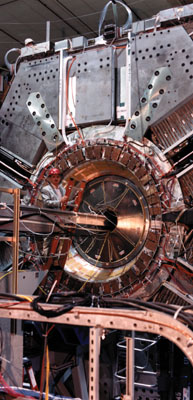The physics of B particles is a major new focus of world particle physics research. A session at the recent lepton-photon symposium provided a useful overview.

Both SLAC in Stanford and the Japanese KEK Laboratory are beginning physics research with new B-factories. The electronpositron annihilations in these colliders are a copious source of B-particles, so called because they contain the fifth “beauty”, “bottom” or simply “b” quark. The decays of these B-particles are expected to reveal new information about CP violation the subtle symmetry breaking widely thought to be responsible for a Big Bang that was matterantimatter symmetric, which eventually produced a visible universe composed entirely of matter.
The factories PEP-II at SLAC and KEKB at KEK use the BaBar and BELLE detectors respectively to study the decays of B-particles.
This new effort for B physics was an overture for the International LeptonPhoton Symposium in Stanford (p6). Jonathan Dorfan, then SLAC director designate, described the PEP-II and BaBar programme. Fumihiko Takasaki of KEK described KEKB and BELLE.
However, there are other B-physics players. Klaus Honscheid of Ohio State covered the programme at Cornell’s CESR electronpositron collider equipped with the CLEO detector. CESR whose collision rate has continually been boosted and CLEO now undergoing its third major facelift have been working in tandem for some 20 years and have made pioneer contributions to B physics.
Warming up on the B touchline is the HERA-B experiment at DESY using the proton ring of the HERA collider. Michael Medinnis of DESY-Zeuthen outlined the detector effort under way en route to scheduled completion next year.
Manfred Paulini of Berkeley sketched the B physics potential of the big CDF and D0 detectors at Fermilab’s Tevatron protonantiproton collider, now fed by the new Main Injector. Also from next year, detector upgrades and collision rate improvements are set to ensure that the Tevatron remains a focus of B physics.
Major contributions also come from LEP at CERN. Not described in the LeptonPhoton Symposium presentations but gearing up for longer-term contributions are the LHCb experiment at CERN’s LHC collider and the BTeV project at Fermilab.
Further reading
The International Committee for Future Accelerators (ICFA) is a platform for the world particle physics community, particularly where international collaboration on major machine projects is concerned. In the aftermath of a recent US Senate recommendation to reduce funding on the Next Linear Collider (NLC) an electronpositron machine to attack the next energy frontier the ICFA issued the following statement after its meeting during the International LeptonPhoton Symposium at Stanford:
“Scientific panels charged with studying future directions for particle physics in Europe, Japan and the US have concluded that there would be compelling and unique scientific possibilities at a linear electronpositron collider in the TeV energy range. Such a facility is a necessary complement to the LHC hadron collider, now under construction at CERN. Experimental results over the last decade from the LEP and SLC electronpositron colliders, combined with those from the Tevatron a hadron collider have led to this worldwide consensus.
“The latest experimental results point ever more clearly to the conclusion that there is fundamentally new physics in the energy range just out of reach of existing colliders. At the very least we will find one or more Higgs scalar bosons or other structure that has the same effect as a Higgs boson. To explore and characterize fully the new physics that must exist will require the LHC plus an electronpositron collider with energy in the TeV range. Just as our present understanding of physics at the highest energy depends critically on combining results from LEP, the SLC and the Tevatron, a full understanding of new physics seen in the future will require both types of high-energy probes.
“Major laboratories around the world are presently conducting accelerator research and development that will lead to detailed designs of a linear electron collider capable of reaching this energy range. The technology being developed for this purpose will also have applications in other areas of science and technology through new generations of intense light sources. A worldwide group is studying the physics at an electronpositron collider and the detectors needed to observe that physics.
“ICFA recommends continued vigorous pursuit of the accelerator research and development on a linear collider in the TeV range, with the goal of having designs complete, with the most reliable cost estimates, in a few years. We believe that an electron collider optimized for the new physics should be built in a timely way with international participation.”
ICFA is a working subcommittee of the International Union of Pure and Applied Physics.








